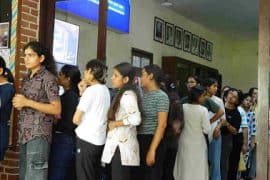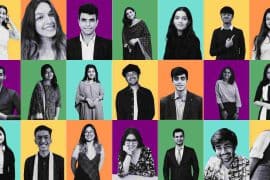This article was written in 2010 and was published in CRTIQUE, an irregular magazine brought out by the New Socialist Initiative (NSI) – Delhi University Chapter. The authors are activists associated with New Socialist Initiative.
Kevin is from Kenya. He studies at the faculty of Law. We ask him whether he likes India (he doesn’t) and about the kinds of challenges he faces. He shrugs and shakes his head “I have don’t face any discrimination” He often repeats this sentence at various points of the discussion. After he tells us about shopkeepers who refuse to sell him milk or before narrating how not a single shop at Patel Chest area was willing to type his assignment. “When you go to buy things from a shop they refuse to sell. If you ask for milk they say ‘no milk’ but you can see the Indians buying milk.” Later he tells us a similar story “My mobile phone was stolen. For one week I was thinking how to get a new one. The shops here don’t sell to Africans.” Kevin doesn’t think much of these experiences and dismisses them as insignificant, the ordinary trials of living in a foreign country. A woman on the road provokes a dog, provoking it to bite him, which it does. At Hans Charitable Trust Hospital they ask him for 10,000 rupees for the anti-rabbis injection. This is a service which is provided free of cost, however the small print reads ‘unless you are black’. Our interviews starkly shows that this particular subtext is present everywhere. We don’t realize that for the most mundane of daily activities (like buying milk) there are conditions that apply. The condition that you are not black.
These interviews give us a glimpse of how these students experience classrooms, hostels, streets, the metro and other public spaces. “What does kala bandar mean?” Boniface asks. They point. They laugh. They don’t like sitting next to you in the metro. What must it feel like to enter a strange foreign country where people across the board categorise you as sub-human? Strangers call you black monkey. “When I go back from college to hostel people on the streets keep laughing and staring. It is humiliating” Boniface says. Kevin stayed in a hotel for two months before joining hostel because no one was willing to rent him a room. The entire gamut of racist discrimination faced by the black students of the university includes everything from actual violence to incessant racist remarks, staring and laughing. This is racism in its purest, crudest and most undisguised form.
If one begins mapping the experiences of these students in north campus of Delhi University there is no choice but to face up to the irrefutable fact that India is a deeply racist society. Yet the idea of racism as a socio-political issue is not one that is associated with India. It grew out of the specific history of European and North American societies and is inextricably linked to the historical fact of colonialism, slavery, displacement and migration. Racism is typically conceived off as exclusively an issue between blacks and white in western societies. We are arguing for the establishment of racism as a serious issue in India, one which is in urgent need of not just study but even basic acknowledgement. However with respect to the particular experiences of these students the onus must be put on Delhi University. The university must be identified as the accountable institution whenever there are instances of racism within its purview; this space includes classrooms, hostels and college campuses. As of now you can call a student a ‘black bitch’ in the university hostel and not face any consequences. As of now racism is not even recognized as a problem. The attitude towards blacks is so normalised and commonplace that the idea of racism as a manifestation of unacceptable bias, prejudice and discrimination is a foreign one. The demand that the university awakens to this issue and takes into consideration the rampant racism which is rooted in university spaces is a basic but essential one. The fact that we have to even demand this basic minimum from the university only goes to show the abysmal degree of neglect.
“There is segregation in the classrooms. In Ramjas College there are three rows: Indians, foreigners and North Eastern students. There is no interaction. They don’t speak to each other. I have an Ethiopian friend in Arts Faculty. It is the same situation there. No on sits close to him and if somebody does then everyone gossips about them. A friend from law Faculty told me it was very bad there. When he would walk into the classroom some students would walk out” This sounds like something out of segregated America of the 1940s. Most African students do not arrive here with a framework of race and racial politics. Why should they? They are coming from black majority countries to a non-white third world country. They come unprepared and don’t anticipate being treated like non-humans. Unless they have friends in India who have warned them or have some understanding of Indian history they enter student life without being able to contextualise or make sense of this treatment. Joyce says, “There are so many Indians in my country. I’m so used to them. I studied with Indians. My father studied with Indians. We don’t see the difference. That is why I find it strange that people stare at me here.”
Kevin’s interview was particularly revealing. He came having done some research of his own by doing an internet search on “racism”. When faced by a vast amount of matter, all to do with racism in the U.S.A he came to the conclusion that it was by definition an American phenomenon. This is probably why he repeatedly told us that he faces no discrimination, while narrating extremely disturbing instances of overt and explicit racism. When you define racism as an issue solely between blacks and whites, then Indian racism which is as entrenched and brutal as in the white dominated counties of the west is conveniently side-stepped. This is deeply problematic. It is truly appalling that there is no language available to talk about the grotesque form of racism that Kevin faces. The deafening silence on the issue of Indian racism robs victims the right to protest and a sense of injustice. How do you even begin a discussion on racism and our fascination with fair skin when there is a complete absence of any critical understanding? By perpetuating this silence we barricade any possibility of debate. We have to start with the very first step, that of exposing Indian racism for what it is. Why does it not shock us that when Boniface walks back home in the evening people on the street point and laugh? Why is someone by virtue of having black skin an immediate target of ridicule? Why is it, of all things, funny? Why does black skin automatically result in being called a monkey? Why is fair lovely? Why is black ugly?
Although it seems obvious, it is important to note that skin colour comes with a powerful symbolic loaded-ness. What are the images constructed around black skin? How are they reproduced and sustained? How did black skin come to denote barbarism and savagery? These are huge complex questions which have no simple answer. To address them in a nuanced manner we are required to dig deep into our history and politics. We need to revisit the long history of colonialism and understand how the logic of dominance played itself out; all this while taking a strong political stance against racism as it exists in all its manifestations today.
Not only is there a pressing need to talk about explicit racism but also to recognise the subtler ways in which our underling prejudices reveal themselves. The fact remains that racism is not an issue of individuals and circumstances but is structural, historical and institutionalized into the very fabric of our society. The general obsession with Europe and the U.S is combined with an absolute neglect of the rest of the world, most of all Africa. It is true this imbalance is a global one and has economic, political and social dimension to it and ultimately whiteness is symbolic of wealth, power and civilization. Black skin came to be constructed as a sign of the uncivilised and barbaric and therefore not ‘us’, not human. This skewed reality which continues to be reproduced today in the post-colonial world, displays itself plainly all over the university in subtle and not so subtle ways.
Editor’s Note: Despite the fact that this piece was written in 2010, not much seems to have changed. Narratives of racism continue to undermine our rationality, as we stare, talk and behave depending on where a person ‘belongs to’. Mandela might have passed away, but what he fought continues to remain.
Guest Post by Aashima Saberwal, Bonojit Hussain and Devika Narayan
Aashima and Devika are Research Scholar and Post-Graduate student at the Department of Sociology, Delhi University; Bonojit is an independent researcher. Research for this article was assisted by Shobha and Meghana from Dept. of Sociology, DSE.



Comments are closed.